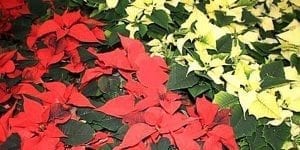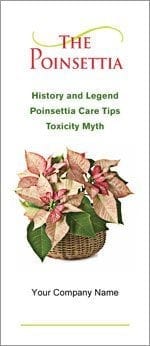 History and Legend of the Poinsettia
History and Legend of the Poinsettia
Joel Robert Poinsett, who was an amateur botanist and the first ambassador to Mexico, first introduced poinsettias to the United States in 1825. He introduced the plant to the United States when he brought some cuttings to his plantation in Greenwood, South Carolina.
December 12 is National Poinsettia Day, an official day set aside to enjoy this symbol of holiday cheer. It was established upon the death of Mr. Poinsett to honor him and the plant he made famous. He died in 1851.
Poinsettias are native to Mexico, where they grow wild. The enchanting legend of the poinsettia dates back several centuries, to a Christmas Eve in Mexico when a little girl named Pepita had no gift to present to the Christ child. Her cousin Pedro urged her to give a humble gift. So, on her way to church she gathered some weeds she found along the road. As she approached the altar, a miracle happened: The weeds blossomed into brilliant flowers. Then they were called Flores de Noche Buena – Flowers of the Holy Night. Now they are called poinsettias.
Poinsettia Care Tips
Poinsettias are one of the longest-lasting blooming plants available to consumers.
To choose the perfect poinsettia and keep it blooming all year long, follow the care tips listed below:
Choosing the perfect poinsettia:
- Pick a plant with small, tightly clustered buds in the center.
- Look for crisp, bright, undamaged foliage.
- Avoid plants displayed in drafty or crowded areas. To keep the poinsettia blooming:
- When surface soil is dry to the touch, water thoroughly. Discard excess water in the saucer.
- To prolong color, keep a temperature range of 60 degrees for night and 72 degrees for day. High humidity is preferable.
- Place plant away from hot or cold drafts, and protect from cold winds. To rebloom for the next season: ? During winter, continue to follow holiday upkeep tips.
- March 1 (St. Patrick’s Day): When bracts fade, cut stems back to eight inches above soil line.
- Continue to water regularly.
- Lightly fertilize with a balanced all-purpose plant food every three to four weeks.
- When temperatures are warm, place plant outdoors; first in indirect, then direct sunlight. Avoid temperatures below 50 degrees throughout the summer.
- July 4 (Independence Day): Cut back new growth stems. Repot if needed.
- Early September (Labor Day): Move plant inside. Provide six or more hours of direct light.
- October 1 through December: Confine plant to complete darkness for 14 hours, giving it 10 hours of natural light daily. This will set the buds and cause bracts to color.
Poinsettia Toxicity Myth
The poinsettia is the most widely tested consumer plant on the market today, proving the myth about the popular holiday plant to be false:
- Scientific research from The Ohio State University has proved the poinsettia to be non-toxic to both humans and pets. All parts of the plant were tested, including the leaves and sap.
- According to POISINDEX, the national information center for poison control centers, a child would have to ingest 500-600 leaves in order to exceed the experimental doses that found no toxicity.
- A study from the Children’s Hospital in Pittsburgh and Carnegie Mellon University found that out of 22,793 reported poinsettia exposures there was essentially no toxicity significance of any kind. The study used national data collected by the American Association of Poison Control Centers.
- As with any non-food product, however, the poinsettia is not meant to be eaten and can cause varying degrees of discomfort; therefore, the plant should be kept out of the reach of young children and curious pets.

